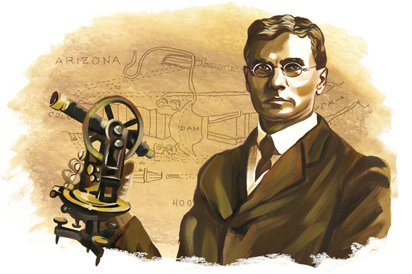
In 1917, a year before World War I ended, Southern California’s Imperial Irrigation District sent a young lawyer named Phil Swing to Washington to urge Congress and the Department of the Interior (DOI) to build a canal that would deliver water from the Colorado River to the Imperial Valley bordering Arizona and Mexico, one of the nation’s driest regions.
After two years of Swing’s effective lobbying, a congressional committee reported favorably on the canal scheme. Swing, who by then had become a congressman, introduced legislation authorizing construction of the so-called All-American Canal, an 80-mile waterway that would stop just short of Mexico. But to the bafflement of Swing and his congressional sponsors, the legislation was defeated because of opposition from a single man: Arthur Powell Davis, director of the U.S. Reclamation Service, a branch of the DOI.
By opposing the All-American Canal, Davis appeared to violate every law of politics and bureaucratic self-interest. After all, his critics wondered, wasn’t it the Reclamation Service’s mission—its very raison d’être—to bring water to the vast agricultural society 19th-century pioneers had established during their relentless march westward under the mythical command of Manifest Destiny?
But Davis was no ordinary bureaucrat. Born in 1861 in Illinois, he was one of the nation’s most respected civil engineers. He played a leading role in the analysis, design and construction of numerous dams, canals and irrigation projects around the world, including the Panama Canal, renowned as one of the world’s largest and most complex engineering feats.
Davis was also a member of an 1888-1893 irrigation survey that led to the passage of the 1902 Reclamation Act and the creation of the Reclamation Service. Further, Davis also had an intimate understanding of the Colorado Basin because of numerous trips he had undertaken to the area with his uncle, John Wesley Powell. A legendary scientist, geologist, teacher and one-armed Civil War veteran, Powell was the first explorer to unravel, as early as 1869, the mystery behind the still-uncharted upper reaches of the turbulent Colorado River.
Finally, perhaps the central reason Davis torpedoed legislation to build the All-American Canal was his belief that the project should only be undertaken as part of a much more ambitious program aimed not just at irrigation but also flood control, water storage and power generation.
In 1922, Davis presented Congress with a comprehensive study of the Colorado Basin. Undertaken with an aim to develop the area, the report was Davis’ personal manifesto for taming the Colorado by building what would eventually become the Hoover Dam, the world’s largest hydroelectric installation at the time and a model for dozens of the world’s greatest dams.
Davis’ most important contribution to the Hoover Dam, which is located on the border between Arizona and Nevada, was his belief that reclaiming the Colorado River was a federal duty. Because the river runs through seven states and into Mexico, “its problems are of such magnitude as to be beyond the reach of other than a national solution,” Davis observed in his report.
Despite—or perhaps because of—the failure of seven states to agree upon how to share the Colorado River’s flow, Davis’ insistence on federal involvement underscored a key reality: “Harnessing the Colorado was too complex, costly and important to be undertaken in piecemeal fashion at the behest of special-interest groups such as the Imperial Irrigation District,” in the words of Joseph E. Stevens, author of a riveting 1988 book, Hoover Dam: An American Adventure.
Unfortunately for Davis, his assiduous support for a federal hydroelectric project earned him the ire of power companies, which, he believed, worked against him. Davis’ cause was further eroded by the fact that he headed an organization that suffered from rampant fiscal mismanagement. Over the years, the Reclamation Service had become the bane of the DOI, whose secretaries came and went without, as one of them put it, “doing something about Reclamation.”
And so it was that Davis was fired in 1923 by a new DOI secretary who had a handy answer to the persistent question of what really plagued Reclamation: The lack of a leader with a business background. That secretary, Hubert Work (himself a physician and former postmaster general) also gave the Reclamation Service a new name—Bureau of Reclamation—and changed the director’s title to that of commissioner.
Davis served as Reclamation director for nearly nine years, having put in eight years previously as the agency’s chief engineer. He was, writes Los Angeles Times Pulitzer-winning journalist Michael Hiltzik in his 2010 book, Colossus: Hoover Dam and the Making of the American Century, “a living symbol of the dominance of engineering ambition over fiscal pragmatism.” That distinction is fittingly recognized in the Davis Dam, named after the famous engineer and located 67 miles downstream from the Hoover Dam.
Davis, who died in Oakland, California, in 1933 at the age of 72, had a “far more sophisticated approach to reclamation than either historians or his critics have conceded,” argues Gene M. Gressley, a professor emeritus of history at the University of Wyoming and a noted authority on the American West.
“True, his orientation was that of an engineer-technocrat, but his speculative rationality ranged far wider than the boundaries set by the graph paper on his drawing board,” writes Gressley of Davis in an insightful 1968 article in the journal Agricultural History.
An individualistic, anti-monopoly progressive, Davis felt comfortable espousing the Jeffersonian idealization of the small homestead, founded on natural rights, while at the same time promoting the opposing utilitarian philosophy of the “greatest good for the greatest number” prescribed by the 19th-century British intellectual Jeremy Bentham. As such, writes Gressley, Davis was a “thorough-going democrat with a small ‘d.’”
A strong proponent of organizational efficiency, Davis detested bureaucracy and “bristled most at the inefficiency of political manipulation,” writes Gressley, adding: “Any small reservoir of patience was quickly exhausted when he found himself confronted by the pork barrel, political pressure from water users and Congressional meddling.”
In the ultimate analysis, however, Davis’ strong romanticism was arguably no different than the sentiments shared by homesteaders, water users and, paradoxically, opportunistic politicians. All of them were “inseparably bound up with the embryonic reclamation vision of transforming the desolate desert into a flourishing garden,” writes Gressley.
Even Davis’ assignment contained a professional paradox. As Gressley aptly put it: “The reclamation engineer, a creature of a technological-industrial civilization, had been designated as an instrument to perpetuate the myth of an agrarian society.”

























